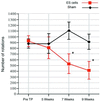Embryonic stem cells develop into functional dopaminergic neurons after transplantation in a Parkinson rat model
- PMID: 11782534
- PMCID: PMC122367
- DOI: 10.1073/pnas.022438099
Embryonic stem cells develop into functional dopaminergic neurons after transplantation in a Parkinson rat model
Abstract
Although implantation of fetal dopamine (DA) neurons can reduce parkinsonism in patients, current methods are rudimentary, and a reliable donor cell source is lacking. We show that transplanting low doses of undifferentiated mouse embryonic stem (ES) cells into the rat striatum results in a proliferation of ES cells into fully differentiated DA neurons. ES cell-derived DA neurons caused gradual and sustained behavioral restoration of DA-mediated motor asymmetry. Behavioral recovery paralleled in vivo positron emission tomography and functional magnetic resonance imaging data demonstrating DA-mediated hemodynamic changes in the striatum and associated brain circuitry. These results demonstrate that transplanted ES cells can develop spontaneously into DA neurons. Such DA neurons can restore cerebral function and behavior in an animal model of Parkinson's disease.
Figures




Comment in
-
Will embryonic stem cells be a useful source of dopamine neurons for transplant into patients with Parkinson's disease?Proc Natl Acad Sci U S A. 2002 Feb 19;99(4):1755-7. doi: 10.1073/pnas.062039699. Proc Natl Acad Sci U S A. 2002. PMID: 11854478 Free PMC article. No abstract available.
References
-
- Olanow C W, Tatton W G. Annu Rev Neurosci. 2000;22:123–144. - PubMed
-
- Olanow C W, Obeso J A. Ann Neurol. 2000;47:167–178. - PubMed
-
- Freed C R, Greene P E, Breeze R E, Tsai W Y, DuMouchel W, Kao R, Dillon S, Winfield H, Culver S, Trojanowski J Q, Eidelberg D, Fahn S. N Engl J Med. 2001;344:710–719. - PubMed
-
- Hauser R A, Freeman T B, Snow B J, Nauert M, Gauger L, Kordower J H, Olanow C W. Arch Neurol (Chicago) 1999;56:179–187. - PubMed
-
- Piccini P, Brooks D J, Bjorklund A, Gunn R N, Grasby P M, Rimoldi O, Brundin P, Hagell P, Rehncrona S, Widner H, Lindvall O. Nat Neurosci. 1999;2:1137–1140. - PubMed
Publication types
MeSH terms
Substances
Grants and funding
LinkOut - more resources
Full Text Sources
Other Literature Sources
Medical

